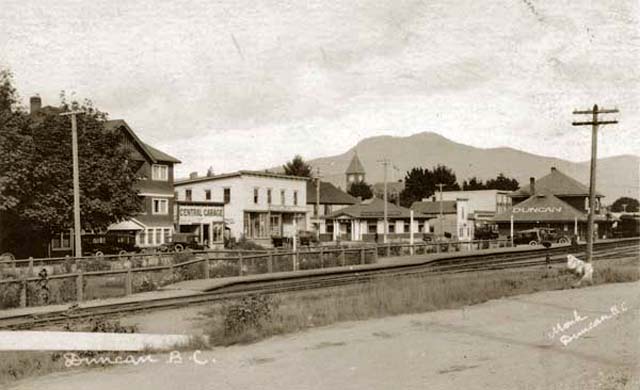
2012
|


Duncan's railway yard and station showing the Tzouhalem Hotel, Central Garage, Jaynes Arcade General store, Bank
of British North America, and the Esquimalt & Nanaimo station on the far right - 1922 Photographer unknown - Cowichan Valley Museum 1998.10.1.32.
19 October 2012
Expanding Rail Yard Challenged New City Council in May 1912
Duncan Vancouver Island British Columbia - Duncan observed its 100th anniversary of incorporation as a city on 4 Mar 2012, and the
Chronicles and the Cowichan Valley Citizen are joining in the year-long celebration with a weekly series of columns about the events leading up to and
following Duncan's secession from North Cowichan Municipality.
Duncan's new council had a full plate in May 1912, with its latest batch of bylaws and, of all things, traffic control.
Specifically, railway traffic, as the CPR wanted to expand its downtown rail yard from four to six tracks to allow for the increase in freight from its new
Lake Cowichan Subdivision.
This placed the city in something of a quandary as council had been courting the CNR Railway to route its mainline closer to the city whereas the CPR had
already established in Duncan (indeed was the reason for Duncan's very being).
The challenge lay in accommodating an expanded rail yard, particularly at what was known as Cowichan Creamery Crossing, where the tracks (now but a single
track) cross today's Coronation Street by the Caprice Theatre. Note the operative word here is crossing.
The problem then, as one can see today, was sufficient space. With the Quamichan Hotel on Duncan Avenue to the east, and the railway station on Front Street
(Canada Avenue) to the west, the nearest public crossing would have to be at the Evans Estate.
That's today's James Street. Meaning, no east-west through traffic on Coronation Road, meaning no east-west through traffic between Trunk and James.
Or the railway would move its freight yards and sheds out of town altogether, at "great inconvenience and expense to the citizens". Council, fearing
the loss not just of railway business, but no doubt, a possible shift of population base, reluctantly accepted the streets and roads committee's recommendation
to let the CPR have its way in exchange for this new, more northerly crossing, on condition that the road allowance be 66 feet wide and that traffic not be
held up for more than two minutes at a time.
And while they were at it, council thought it a good idea to approach North Cowichan about extending Duncan Avenue (sic) as far as the new crossing.
Not all issues were so problematic for the newly-elected city fathers, of course, and it must have been a slight relief for Mayor Duncan and councillors, who
were still feeling their way in civic management, to turn to such mundane matters as ordering dog licences, installing waste receptacles about town, providing
citizens east of the railway tracks with increased fire protection, a hose reel, and appointing James Rutledge as chief of the Duncan Fire Brigade.
So it was 100 years ago. You know, the good old days.
T.W. Paterson.
Editor's Note: Article abridged - non-railway related content removed.

|


|
Vancouver Island
British Columbia
Canada
|
|


